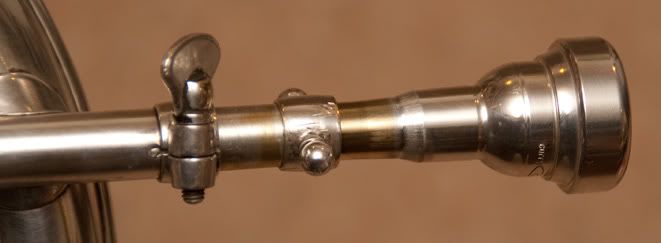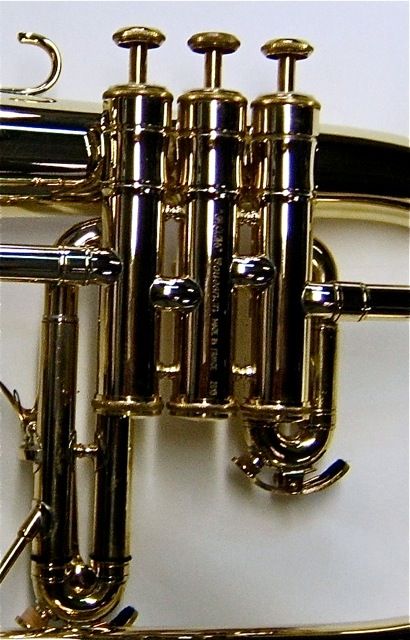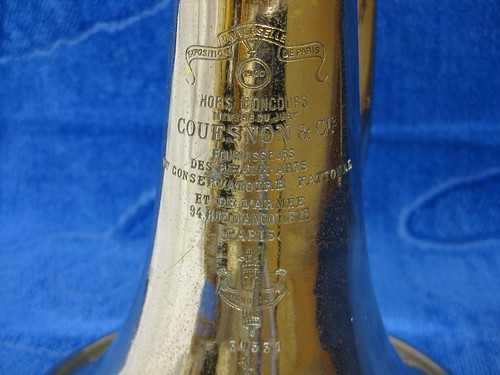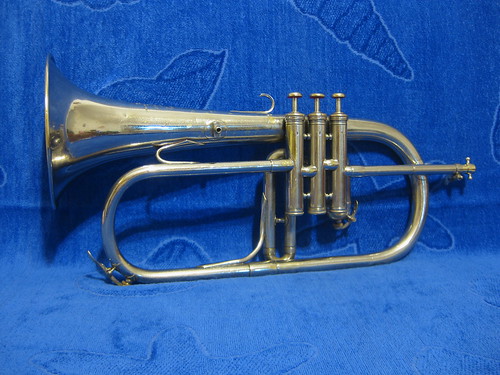| View previous topic :: View next topic |
| Author |
Message |
goodmusiknmyear
New Member
Joined: 27 Sep 2012
Posts: 6
|
 Posted: Thu Sep 27, 2012 9:12 am Post subject: Posted: Thu Sep 27, 2012 9:12 am Post subject: |
 |
|
| Where can I find a great flugelhorn for cheap? |
|
| Back to top |
|
 |
royjohn
Heavyweight Member
Joined: 12 Jan 2005
Posts: 2272
Location: Knoxville, Tennessee
|
 Posted: Thu Sep 27, 2012 9:25 am Post subject: Posted: Thu Sep 27, 2012 9:25 am Post subject: |
 |
|
A little more info about your requirements and situation might help.
New or used or either? Does the finish matter? Would you play a beat up horn if it played great? How old is too old? Can you deal with a receiver that might not take a standard flugel taper? Are you aware that people who have never played flugel or trumpets in other keys besides Bb often have trouble with intonation quirks of flugels?
What sources would you be comfortable buying from --- local store, recognized mail order business (e.g., Dillons, Quality Brass, wwbw, musician's friend), TH marketplace, ebay, Craig's list, etc.
Is this going to be for casual doubling, for fun, or on gigs, or for serious jazz gigging or . . . . ?
And of course, how much cash ya wanna drop? Is resale value going to be an issue down the road?
Old dogs on CL or ebay, maybe real fixable, $150 to $300; new or slightly used Jupiter, m/b $500 to $800; old Couesnon in good shape, $700 to $1200. You do the price research for the pro horns . . . . close to $2K and up . . . .
_________________
royjohn
Trumpets: 1928 Holton Llewellyn Model, 1957 Holton 51LB, 2010 Custom C by Bill Jones, 2011 Custom D/Eb by Bill Jones
Flugels: 1975 Olds Superstar, 1970's Elkhardt, 1970's Getzen 4 valve
Cornet: 1970's Yamaha YCR-233S . . . and others . . . |
|
| Back to top |
|
 |
Voltrane
Heavyweight Member

Joined: 20 Jan 2006
Posts: 629
Location: Paris (France)
|
 Posted: Thu Sep 27, 2012 10:32 am Post subject: Posted: Thu Sep 27, 2012 10:32 am Post subject: |
 |
|
Hi,
ChrisJ, it seems the Monopole Conservatoire model appeared in 1932-1934. In the picture below (1934 catalog), regarding the 141 the text says: "Big Flugelhorn in Bb, new 1932 bore..." So it is not the same bore than the original Monopole (123,139 and 140 in this picture).

Royjohn, yes, the text is very interesting. Even on the small picture above we learn than the flugel is the old german/english bugle adapted with keys by Monsieur Frichot around 1800 and Herr Weidinger around 1820...
Regards
Marc |
|
| Back to top |
|
 |
Chris J
Regular Member
Joined: 26 Sep 2012
Posts: 15
Location: Southampton UK
|
 Posted: Thu Sep 27, 2012 2:51 pm Post subject: Posted: Thu Sep 27, 2012 2:51 pm Post subject: |
 |
|
Marc
These old catalogues are real gems of information.
In a spare moment today, I looked at the website of the company that uses the Couesnon name, P.G.M. I noticed they sell what they call an "old design" flugelhorn.
With nothing to lose, I emailed the company asking if they could tell me which "old design" these are based on. I will let you know if they reply, or indeed that information may already have been discussed in the forum. I admit to not having checked!
To display my ignorance, a question - when an instrument bore size is quoted, which bit of the bore does that measurement refer to?
I had mentioned in my first post that I play the beautifully made saxes. One example of their attention to detail is the finishing of the bell rim. Almost all other sax makes have a rolled bell, but the later Couesnons (from late 1940s) have a folded, pressed rim which is much stronger. You can just about make it out in the photo below of one of my tenor saxes.
Does this exist on later flugels - mine has a simple rolled rim?
Chris
 |
|
| Back to top |
|
 |
Voltrane
Heavyweight Member

Joined: 20 Jan 2006
Posts: 629
Location: Paris (France)
|
 Posted: Fri Sep 28, 2012 8:44 am Post subject: Posted: Fri Sep 28, 2012 8:44 am Post subject: |
 |
|
ChrisJ,
1- I had a look at the PGM site and I think the "Old design" is a shortcut obviously due to a lack of...technical english knowledge in PGM. The French version is more elaborated: it is "jeu de chemise ŕ l'ancienne avec balustres". As far as I remember "chemise" means valve casing in French repairmen jargon so it seems related to the valve casing. But I do not really understand so I will ask to specialists in the French Forum. (For the fun: if I translate from common French to common English it means set of old fashioned shirts with column  !) !)
2- As far as I know the bore is currently measured where the 2nd valve connects to its slide.
3- I also assume the Monopole logo is related to fasce. As explained on the wikipedia page you quoted it is an old and very common French symbol coming from Roman Empire. Moreover the Francs (barbarian that invaded Roman Empire and settled in what is now France had as favorite weapon an axe named "Franscisque". Google Francisque and you will see how it looked like. Very close to the axe in the French fasce.
4-Your sax seems very interesting.Regards
Marc |
|
| Back to top |
|
 |
Chris J
Regular Member
Joined: 26 Sep 2012
Posts: 15
Location: Southampton UK
|
 Posted: Fri Sep 28, 2012 9:52 am Post subject: Posted: Fri Sep 28, 2012 9:52 am Post subject: |
 |
|
Marc
Today I got a reply from P.G.M. - I asked which model the Old Design was based on. The reply was "This model was already in our catalogue in 1934"
Given that I understand there have large and small bore instruments, and possibly some design changes on the way, I suspect their answer was just shorthand for saying "Look, its just old, OK?"!
If you find out that the "Old Design" is indeed based on the 1934 Monopole Conservatoire model, and that particular model was not subject to a variety of bore sizes or design changes, then I would be interested to hear.
And thank you for the information regarding how bore size is measured.
The saxes are excellent, as are the Monopole clarinets. But I am biased - at the last count I have 10 Monopole Conservatoire saxes ranging from baritone to soprano, and 3 Monopole clarinets, one being a metal, double walled instrument!
If people have not had a close look at the Monopole logo before, here is a clear view from one of my clarinets

I see what you mean about the Francisque. The French were not the only nation to adopt the Fasce in its symbolism, though!

Chris |
|
| Back to top |
|
 |
Voltrane
Heavyweight Member

Joined: 20 Jan 2006
Posts: 629
Location: Paris (France)
|
 Posted: Fri Sep 28, 2012 10:06 am Post subject: Posted: Fri Sep 28, 2012 10:06 am Post subject: |
 |
|
ChrisJ,
I will mail in French to PGM. I think they have difficulties to explain in English and hope that is why they make laconic answers.
Will post when/if I have answers.
Regards
Marc |
|
| Back to top |
|
 |
Chris J
Regular Member
Joined: 26 Sep 2012
Posts: 15
Location: Southampton UK
|
 Posted: Sat Sep 29, 2012 1:07 pm Post subject: Posted: Sat Sep 29, 2012 1:07 pm Post subject: |
 |
|
Just an update on the mouthpiece situation.
I emailed Mark Curry for advice, and he was very generous with his time and emailed a comprehensive reply. He suggested soaking the leadpipe in vinegar to remove any calcium deposits, which it did. But the mouthpiece was still not going in. The next step was to take some fine grit paper (600) and sand the shank. I had not realised the tolerances of these thinks are so small, and after a couple of sanding and trying, the mouthpiece fits snugly, and importantly, is removable too!
So all is solved. I think the mouthpiece is far enough in the leadpipe to be acceptable?

Chris |
|
| Back to top |
|
 |
Voltrane
Heavyweight Member

Joined: 20 Jan 2006
Posts: 629
Location: Paris (France)
|
 Posted: Tue Oct 02, 2012 11:40 pm Post subject: Posted: Tue Oct 02, 2012 11:40 pm Post subject: |
 |
|
Hello,
I have my answers: The difference between the PGM 142 and the PGM 142 B is the valve casing design. The “old design” relates to this and not in the horn design. The famous ” jeu de chemise” is the valve block (not the valves). So, as far as I understand, in the “old time” the valve block was made of two soldered parts. The French name of the upper part is “balustres” and it can be straight like that “||” or a little curved ( like that “()” or similar). That is a picture of the "old design" 142B valve casing.

The 142 is straight, the 142B “old design“ . According to PGM it is only a different look
But a French repairman told me that is the “old time”, the balustres could be made of “maillechort” an alloy supposed to be more resistant and heavier than brass (I am not sure of the translation of maillechort in English but my French/English dictionary says nickel silver…). If you have a look at the picture I posted above, the 141 and 138 Monopole Conservatoire descriptions quote explicitly maillechort (regarding valves for the 141 and valve block for the 138). Nothing about maillechort in the Monopole. So may be is it a difference between the 2 models?
Moreover my own Monopole 140 made @1975/80 is obviously straight and in one part. Another difference? The PGM Monopole Conservatoire has a 10.50 mm bore. Unfortunately I do not remember the bore of the Monopole and do not have my caliber. May be someone knows this?
I asked PGM whether their Monopole Conservatoire was a clone of the 1934 Couesnon model but I had no answer (according to the answer they made to ChrisJ, it seems so but they did not confirm to me).
Regards.
Marc |
|
| Back to top |
|
 |
laurent
Heavyweight Member

Joined: 12 Sep 2009
Posts: 897
Location: Barcelona (Spain)
|
 Posted: Wed Oct 03, 2012 2:15 am Post subject: Posted: Wed Oct 03, 2012 2:15 am Post subject: |
 |
|
Hi! 
| Voltrane wrote: | | The PGM Monopole Conservatoire has a 10.50 mm bore. Unfortunately I do not remember the bore of the Monopole and do not have my caliber. May be someone knows this? |
As far as I know, in the past Couesnon produced the Monopole flugel in two bore sizes: small - .415", 10.5mm -, and medium - .433", 11mm.
Although the version most apreciated and famous of the Monopole was the small bore, the Yamaha 631, which is so much copied nowadays, is based on the medium bore version. 
_________________

Bb Trumpets: Courtois Évolution IV, Stomvi Forte,
Buescher T-120, HT3.
Mpcs: Monette B2s3, Kanstul M-B2.
Flugel: H.Bagué (Yam 631 clone in red brass).
Mpcs: Curry FL & FLD. |
|
| Back to top |
|
 |
Flugelnut
Veteran Member
Joined: 24 Jul 2004
Posts: 478
Location: The Netherlands
|
 Posted: Wed Oct 03, 2012 9:56 am Post subject: Posted: Wed Oct 03, 2012 9:56 am Post subject: |
 |
|
Chris: you're asking wether your Curry mouthpiece is inserted far enough in the leadpipe. I think that it's designed to go in as far as the first step in diameter, meaning that the complete cylindrical section is in the pipe.
If you have no tuning problems in that the horn plays flat and the piece seats OK, don't worry.
Glad you solved your problem. |
|
| Back to top |
|
 |
Chris J
Regular Member
Joined: 26 Sep 2012
Posts: 15
Location: Southampton UK
|
 Posted: Wed Oct 03, 2012 2:22 pm Post subject: Posted: Wed Oct 03, 2012 2:22 pm Post subject: |
 |
|
| Flugelnut wrote: | | I think that it's designed to go in as far as the first step in diameter, meaning that the complete cylindrical section is in the pipe. |
Many thanks for following this up. I did contact Mark Curry, who again very promptly replied. He said much the same as you, but as it is easy to sand the shank with 600 grit paper, I took a little more of the upper part of the shank, and it now fits snugly all the way up to the first widening crease of the mouthpiece shank.
Intonation is now down to me!...
Chris |
|
| Back to top |
|
 |
Chris J
Regular Member
Joined: 26 Sep 2012
Posts: 15
Location: Southampton UK
|
 Posted: Wed Oct 03, 2012 2:40 pm Post subject: Posted: Wed Oct 03, 2012 2:40 pm Post subject: |
 |
|
Marc
Thank you for your further information regarding the Old Design Monopole Conservatoire.
I have been looking to buy a Monopole flugelhorn for quite some time before I landed the one I bought recently. I don't recall ever noticing a picture of the valve block looking anything other than straight and single piece, as is mine. But then again, I was not looking out for it.
I would be interested to see photos of any actually old Monopoles like that.
I can confirm that my instrument has a bore 10.5 mm as measured at the second valve
Chris |
|
| Back to top |
|
 |
Paul2
New Member
Joined: 13 Nov 2012
Posts: 1
|
 Posted: Tue Nov 13, 2012 9:18 pm Post subject: Couesnon Flugel Posted: Tue Nov 13, 2012 9:18 pm Post subject: Couesnon Flugel |
 |
|
Hi Cyber_shake,
My Couesnon flugel is closer to yours than any other I've seen. #78193, also with 140 stamped vertically above the 2 on the second valve casing and an 'N' on the opposite side. I bought it about 5 years ago and have had no idea of its year of manufacture. I believe you said yours was new in '79? Mine should be right in there somewhere, as well. Thanks for posting the info! 
BTW, it sounds wonderful!
Paul |
|
| Back to top |
|
 |
botahoratiu
Veteran Member
Joined: 20 Jul 2010
Posts: 390
Location: Medias, Romania
|
 Posted: Tue Apr 16, 2013 11:58 am Post subject: Posted: Tue Apr 16, 2013 11:58 am Post subject: |
 |
|
I have a Couesnon Monopole flugel with a 21 stamped in the pinapple, #30531 listed in the Marketplace. There are a lot of photos and infos about it .
Enjoy!

020 by botahoratiu, on Flickr

022 by botahoratiu, on Flickr

012 by botahoratiu, on Flickr
_________________
Getzen Eterna 900s
Yamaha Bobby Shew Lead |
|
| Back to top |
|
 |
iiipopes
Heavyweight Member

Joined: 29 Jun 2015
Posts: 548
|
 Posted: Sat Sep 26, 2015 3:25 pm Post subject: Posted: Sat Sep 26, 2015 3:25 pm Post subject: |
 |
|
Couesnon Comparison Comments
I have at hand not one, but two, yes two, Couesnon flugelhorns for comparison and review. Neither of them has “Monopole” or “Star” or a “grenade” or “pinapple” with a number in it, or any other markings on the bell other than Couesnon Paris [serial number] Made in France. To keep the balance between objective and subjective comments, I had another friend who has a music ed degree in elementary band, including training to fit instruments to beginning players, help me with the observations.
My friend’s flugel is serial number 82xxx with the “o in the C” style of engraved markings, model 2155. “A” under the second valve slide, and a strange triangle-shaped mark with the number “12” on the knuckle of the external mouthpipe receiver. Lacquer finish. It has the original hang tag/warranty card with its original mouthpiece, lyre and case keys in its original case. My friend is the second owner. From what we know the first owner bought it new in the early ‘70’s, but he is now deceased and that is as close as my friend and I can get to dating the instrument. The Gretch warranty card has the same logo that you see on current website. With its original Couesnon #3 mouthpiece, it has a good, but slightly bright for flugel tone. Pulling and setting the valve slides, it has good intonation through the range, and you can tell it is a Couesnon. It benefits from a deeper mouthpiece, like the Curry FLD, which darkens the tone, and on this particular horn, really doesn’t cause anything to go flat as you go up the register. But up around Bb above the staff on up can require a significant amount of focus to center intonation, but then again, this is a flugel. I find the instrument needs good breath support and a little more work to bring out what it has to offer. A good section horn, even if low D 1+3 and C# 123 are stuffy.
Mine is serial number 76xxx with smaller block stamped letters, including “B” below the second valve slide. Silverplated. I purchased it from musicalmason1 here on the forum. Great guy to deal with. I recommend him. It sounds great! It is all Couesnon in all its glory - dark, but also piquant, smoky, inimitable, etc. What I think is lost in the modern quest for a tone “as dark as possible” is the overtone profile that truly distinguishes true flugel tone from simply or merely dark tone, and from trumpet and cornet tone. This one has it. This will be an esoteric comparison, but it is not simply dark or hollow like a large scale pipe organ stopped flute, but it has the signature tone that lets it blend like a pipe organ rohrflute stop – which is the same pipe, but with the tube in the top of the stopper to bring out a particular upper partial to blend, and is one of the most signature of pipe organ tones. Mine has the flugelhorn version of that, which I call piquancy, as opposed to many other horn/mouthpiece combinations which are merely dark. This singular aspect of the overall tone quality serves to make the horn work for both solo and section work.
Intonation on my horn, with the slides set as Tom Turner advises, is remarkable throughout the entire range of the instrument. It actually plays better than my friend's horn even when the slides are set the same way. Not only does it have great intonation, but the blow is as free and even blowing as it gets. Slurs just pop. Legato lines flow. Marked intonation and louder dynamics are defined without being harsh. Yes, it has a limit – fortissimo does sound forced and you can tell the horn just doesn’t want to go there. But up to forte it retains integrity of tone and intonation. It is actually easier to play overall – the horn seems to “play itself” – with the stock mouthpiece, especially when you let up slightly and let the horn do what it is best at. But with a deeper mouthpiece, like a Curry FLD, it loses its piquancy, and the upper register goes flat. And it is just that – quality of tone, not overall brightness or darkness of tone.
A major quirk about my horn: it has "318" on the external lead pipe knuckle. When I did my research, including this thread, it seems that on the older horns, "318" indicated the Eb soprano flugel model. So I surmised mine would have a slightly shorter external leadpipe. Sure enough, when you compare the outer leadpipe to my friend's horn, the leadpipe is @5/8 inch longer on his, shorter on mine, and the mouthpiece goes in farther into the receiver on mine. I don’t know if this helps with the intonation or not, and I cannot tell if it is stock or an old repair, or if the inner leadpipe receiver has been reamed on mine, but whatever it is, I’m sure it is a singular instrument having the “wrong” leadpipe! I tend to think it is just what this horn is, as the Curry F shank fits the same and as well as the stock mouthpiece – no wobble or other indication of anything but just a good seating of the mouthpiece.
And now, the Karma: right after I purchased mine, I started looking for a mouthpiece. A person had just posted on Craigslist in another city about 200 miles from where I live an authentic, same era Couesnon #3 flugel mouthpiece, which was in a box of miscellaneous mouthpieces that were being cleared out - for $20. Well, we all start mouthpiece safaris somewhere, so I thought this would be a good place. WOW! I may be the only person who has a horn which sounds best with an original factory mouthpiece. And the cup diameter and rim profile are almost exactly like the Yamaha Shew Jazz I play on my King Super 20 trumpet, so doubling is easier. But here is the strangeness – think about notorious Bach inconsistency – there must be something different in the backbores of the two otherwise identical mouthpieces, because on my friend’s horn my mouthpiece is stuffy and will not bring out the tone. Likewise, his mouthpiece makes my horn sound more “trumpety,” even though the cups and throat diameter are nominally the same. OTOH, his mouthpiece helps his horn sound more even, even if about a half-shade brighter, and my mouthpiece brings out the ultimate signature delicious, piquant, smoky, inimitable tone on my horn, with proper intonation when the slides are set properly, as Tom Turner talks about. Yes, I took out a tuner, and confirmed the superlative intonation across the registers.
I have posted a link to pictures below so you can see the difference a few years makes in the cosmetics. Notice the different valve buttons and caps, and of course the leadpipe. But I have taken my calipers, and I can’t find anything of any significant difference in the two horns, except that my friend’s horn may have a slightly wider valve block, by a couple hundredths of an inch. His bell throat appears to be just ever so slightly tighter than mine, but the measurements do not bear that out. Let’s just say it feels tighter, with the horn having a little more resistance overall than mine. I also cannot tell if the difference in silver plate versus lacquer makes any difference, because some of his lacquer is worn, and silver plate is usually neutral to the tone of the horn.
The bottom line: just like any instrument, if considering a purchase – set a budget, play many, take notes, and be patient. I waited thirty years to find the flugel for me. As a 53-year old comeback player, I have found my flugel.
Thanks to the moderators for allowing this very long post.
http://s1027.photobucket.com/user/iiipopes/media/Flugel%20Comp%202_zpsiouu6esu.jpg.html?filters[user]=144013173&filters[recent]=1&sort=1&o=0 |
|
| Back to top |
|
 |
BenH
Heavyweight Member
Joined: 28 Aug 2007
Posts: 848
Location: United Kingdom
|
 Posted: Sat Nov 21, 2015 1:35 am Post subject: Posted: Sat Nov 21, 2015 1:35 am Post subject: |
 |
|
Reviving a zombie thread... For those with Queenies with a pineapple on the bell, do you have a ridge on the inside of the outer leadpipe tubing? Mine is from 1945, and the original leadpipe fits fine, but the replacement GR/Melk I've ordered is a slightly larger diameter and bottoms out on this ridge. There's nothing on the outside to suggest that it's there. I've spoken to one other guy with a horn from the same year who had the same issue. If anyone else has this I'd be interested to hear, as it's not something Bri from GR has come across (the replacement pipes are designed to drop in with no modifications necessary). It seems... Odd. I guess that's vintage horns for you!
_________________
Schilke B1
Couesnon flugelhorn |
|
| Back to top |
|
 |
iiipopes
Heavyweight Member

Joined: 29 Jun 2015
Posts: 548
|
 Posted: Sat Nov 21, 2015 6:16 am Post subject: Posted: Sat Nov 21, 2015 6:16 am Post subject: |
 |
|
| BenH wrote: | | Reviving a zombie thread... For those with Queenies with a pineapple on the bell, do you have a ridge on the inside of the outer leadpipe tubing? Mine is from 1945, and the original leadpipe fits fine, but the replacement GR/Melk I've ordered is a slightly larger diameter and bottoms out on this ridge. There's nothing on the outside to suggest that it's there. I've spoken to one other guy with a horn from the same year who had the same issue. If anyone else has this I'd be interested to hear, as it's not something Bri from GR has come across (the replacement pipes are designed to drop in with no modifications necessary). It seems... Odd. I guess that's vintage horns for you! |
How far out does the leadpipe stick out when seated? Will it still tune, or is is out so far the horn is flat no matter what you do? If the GR pipe goes in almost all the way, can it be trimmed so it doesn't matter if it bottoms out, if you still have the adjustment necessary?
Can you post a picture of the two leadpipes side-by-side? Besides any difference in diameter, are there any other differences between the two pipes that are noticeable - length, taper (although both should be straight), marks on the side or running up the edge of one pipe or the other that might indicate interference internally, being out-of-round, etc.?
It also sounds to me like it could be a blob of solder worked itself to the inside of the outer pipe ferrule. Have you had the leadpipe scoped or bright-lighted to determine if this is the issue, or if it simply is a difference in construction of the two pipes with the diameter of leadpipe?
For example, mine has obviously been repaired, but using an Eb soprano leadpipe instead of a Bb leadpipe (the outer pipe is shorter and has "318" on the receiver knuckle). Since I have enough inner leadpipe to pull down to pitch, I don't worry about it. It sounds great as it is. I'm probably one of the very few who actually prefers the stock leadpipe and factory mouthpiece, and mine actually plays in tune when I set the 3rd slide out about 5/8 to 3/4 inch and pull the 1st valve slide just a hair, and doesn't go flat above the staff with the factory mouthpiece. It may be the same way for your leadpipe - just trim it, set it, forget it, and enjoy playing it.
_________________
King Super 20 Trumpet; Sov 921 Cornet
Bach cornet modded to be a 181L clone
Couesnon Flugelhorn and C trumpet |
|
| Back to top |
|
 |
adagiotrumpet
Heavyweight Member
Joined: 31 May 2006
Posts: 903
|
 Posted: Sat Nov 21, 2015 8:15 am Post subject: Re: spit valve Posted: Sat Nov 21, 2015 8:15 am Post subject: Re: spit valve |
 |
|
| junkyt wrote: | Good information! We're slowly but surely filling in the gaps.
I have what I think is a 70's 2155 model, but with a twist. The main spit valve, rather than point up toward the bell, is on the bottom of the pipe, pointing back toward the mouthpiece.
Anyone come across one of these before? |
Mine has the same main spit valve. "1","2", and "3" is on the left side of the corresponding valve casing, and a "D" on the right side of the second valve casing. The serial number is 55,XXX and the "O" is inside the "C" in COUESNON. The finger buttons and valve slide ferrules seem to have more detail that what I have seen. Anybody have any idea how old this horn is? |
|
| Back to top |
|
 |
BenH
Heavyweight Member
Joined: 28 Aug 2007
Posts: 848
Location: United Kingdom
|
 Posted: Sat Nov 21, 2015 8:47 am Post subject: Posted: Sat Nov 21, 2015 8:47 am Post subject: |
 |
|
The GR pipe only inserts about an inch, so it's way flat. If it was trimmed there would be no scope for tuning.
No photos at the moment, but the pipes are the same length (I measured the original one as per instructions). The original is dented but I don't believe that's related; although I haven't had the outer pipe scoped, I have shone a flashlight down it and there's a visible ridge all the way around. The internal diameter suddenly decreases about an inch in, but there's no sign from the outside that this happens.
_________________
Schilke B1
Couesnon flugelhorn |
|
| Back to top |
|
 |
|
|
You cannot post new topics in this forum
You cannot reply to topics in this forum
You cannot edit your posts in this forum
You cannot delete your posts in this forum
You cannot vote in polls in this forum
|
Powered by phpBB © 2001, 2005 phpBB Group
|